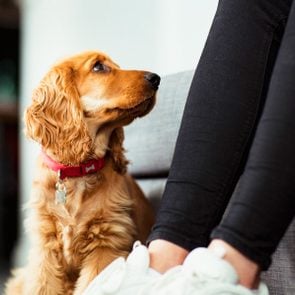How to Get Dog Poop Out of Carpet and Other Hard-to-Clean Spots
Updated: Apr. 25, 2024
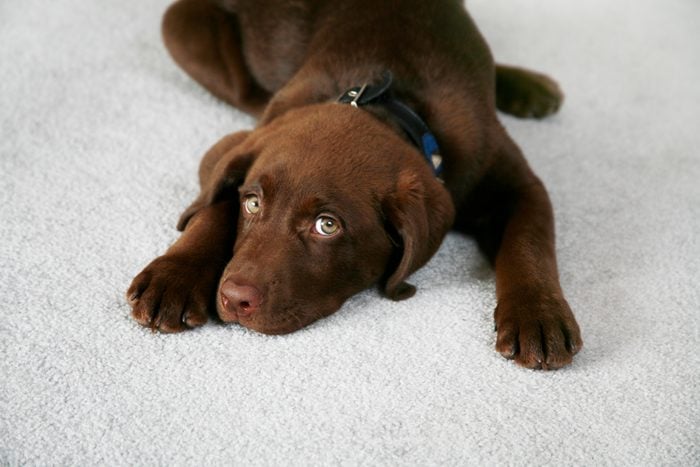
Did your pet have an accident? Whether it's an old mess or a new one, these tips from the pros will help you get dog poop out of your carpet and upholstery.
Pet parents, you know the drill. You get home from work or from picking up the kids, and your nose crinkles. That wasn’t there when I left. Your eyes pan the room. Where is it coming from? Where’s the dog?! That unmistakable whiff of dog poop is hard to forget, and the stains left behind are even harder to remove. So your mind races: Do I know how to get dog poop out of carpet?
On This Page
How do you clean dog poop off carpet?
Turns out, it’s easy—if you jump on it right away. “The earlier you remove any contaminants or soils, the easier it is to get good results,” according to cleaning specialist Jeff Cross of ISSA, the worldwide cleaning industry association. As the former owner of a successful cleaning and restoration company, Cross knows dog poop, and he says even though homeowners don’t have the same tools as the pros, patience—and simple household cleaners—will help get dog poop out of carpet.
Below, we talk to Cross and carpet-cleaning experts from Bissell Homecare and the Carpet and Rug Institute (CRI) to teach you how to clean carpet like a pro. If your good boy left you a special present, don’t scold or yell at him—he won’t know what you’re upset about. Just remove your pup from the area and get to work cleaning before stains set and are hard to remove. Of course, that doesn’t mean your furry pal can poop all over your house! A veterinarian and certified pet behaviorist weighs in later with solid strategies to help you redirect your pooch’s pooping.
But first, let’s talk about dog poop: fresh poop, dried poop and all stages in between. Ahead, you’ll learn how to remove these stains from carpeting and upholstery.
Get Reader’s Digest’s Read Up newsletter for more pets, humor, travel, tech and fun facts all week long.
About the experts
Reviewed for accuracy by: Ann Russell, TikTok’s “cleaning auntie” and the author of How to Clean Everything. |
How to get dog poop out of carpet with dish soap
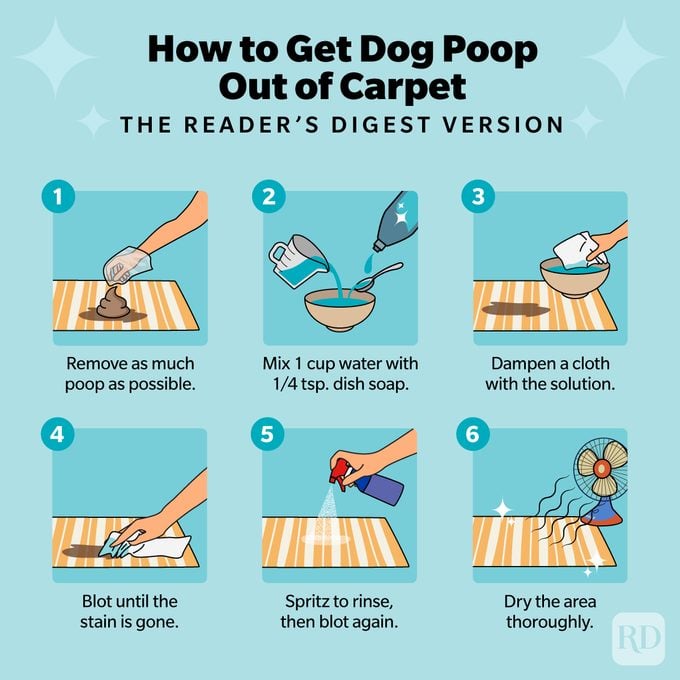
Don’t let a stinky pile of poo send you into a panic. Relax! You don’t need fancy cleaners. “Keep it simple,” Cross says. “Feces is easy to remove with mild detergent and warm water.” Start with dish soap (which is actually a detergent). It’s safe, inexpensive and, unless you eat nothing but takeout, probably already sitting under your sink. Detergents have surfactants that surround dirt molecules (or in this case, poop molecules) and lift them away.
You can use dish soap on any kind of poop stain—fresh, dry, loose or even diarrhea—but the bigger the stain, the longer it’s going to take. Patience will help.
Supplies you’ll need
- Plastic bag or gloves
- Paper towels
- Spoon
- Dish soap
- Small bowl
- Dry white towels
1. Remove as much poop as possible
“Pick up what you can,” Cross says. You can use a plastic glove, bag or paper towel to avoid touching the mess. Any solid chunks or loose material can go right into the trash. If the poop is semi-solid, scoop it up with a spoon. Blot liquids with a clean paper towel. Work from the outside inward to keep the stain contained to the original area.
2. Mix dish soap and water
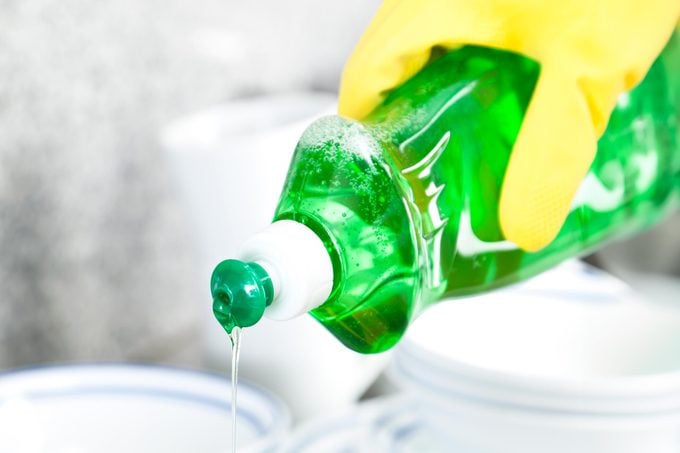
Add one-quarter teaspoon of dish soap to one cup of warm water. Resist adding more soap! “Never use a stronger concentration,” says Karen Cady, program manager for the CRI Seal of Approval cleaner-certification program. Additional soap is hard to rinse out and will leave a residue.
Cross agrees. “A bowl of warm or hot water with a few drops of dish detergent will work wonders,” he says.
3. Apply the soapy water to the stain
Grab a clean, white cloth. (Using white will help you avoid color transfer.) And don’t worry: You’ll thoroughly clean your towel afterward.
Dab the cloth into the water and apply the liquid to the poop stain. “Just don’t over-apply the solution,” Cross says. You’re trying to clean the fibers, not get the carpet base and pad wet.
Start at the edge of the spot and blot, moving inward. “Work gently; do not rub,” Cady says.
4. Blot. Blot. Blot.
Allow the solution to remain on the stain for a few minutes. Blot and reapply the soapy mix with your towel. Be patient. You may have to repeat these steps several times. “If you see results, keep working,” Cross says. If the water gets dirty, make a fresh solution. Switch to a clean towel as needed.
5. Rinse and dry
Rinse the area thoroughly. Cady likes using a mist-type sprayer to prevent over-wetting the carpet, which can cause mold and other damage. “Use towels, minimize the moisture and blot until dry,” Cross says. Or use a fan to dry the spot faster.
How to get dog poop out of carpet with vinegar
Dish soap isn’t the only ingredient useful in removing dog poop from carpeting. Natural, inexpensive white vinegar also wins CRI approval and can be used safely on most carpeting if you prefer it to dish soap or commercial cleaner (more on that below). Test it out in an inconspicuous area first—a good tip for any and all carpet-cleaning projects.
These steps are for fresh poop of any consistency. If you’re dealing with poo that has dried into the fibers, skip to the next section.
Supplies you’ll need
- Plastic bag or gloves
- Paper towels
- Spoon
- White vinegar (5% acetic acid)
- Medium bowl
- Dry white towels
1. Remove as much poop as possible
For fresh, solid poops, use a paper towel to pick up the pieces. Or stick your hand in a plastic dog poop bag like you’re standing awkwardly in your neighbor’s yard, waiting for your pup to do its business. Rubber gloves work too.
Pick up all of the solid pieces. Scoop up looser poops with a spoon. “Blot any liquids with a dry, white absorbent cloth or white paper towels,” Cady says.
2. Make a vinegar solution
Add one cup of plain white vinegar to two cups of water in a medium bowl. Vinegar smells a little tart, but it cleans great and has natural antibacterial properties. Plus, the smell is temporary and works as a deodorizer. It’s cheap too. What’s not to love?
3. Apply, blot and repeat
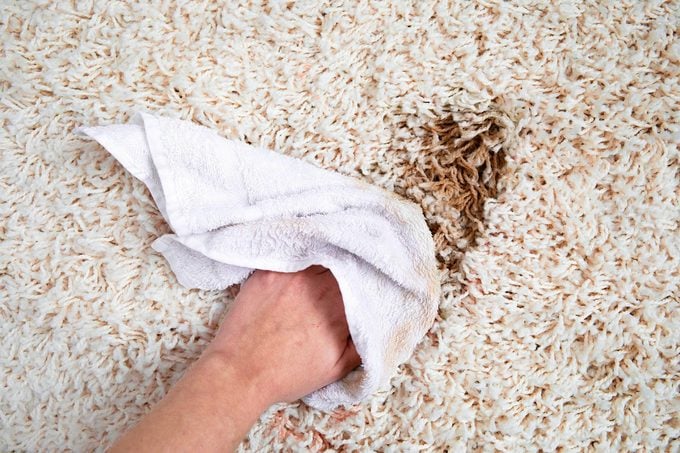
Using a clean white cloth, apply the vinegar solution to the poop spot. Don’t use too much cleaner, though. You want enough liquid to clean the carpet fibers, not so much that the entire area is soaked.
Work from the outside in so the stain doesn’t spread. Using a fresh part of the cloth each time, repeatedly dab the vinegar solution onto the stain. Blot, dunk and repeat.
4. Rinse and dry
When the stain is gone, rinse the area thoroughly to remove all residues of cleaner. Remember not to soak the entire carpet. Cady again recommends a misting sprayer to wet the fibers while keeping water to a minimum. Wet and blot the area several times. Dry with a clean cloth or use a fan.
How to get old dog poop out of carpet
Finding a fresh pile of poo is one thing, but what if it’s been there a while? The process is similar but includes a few tweaks, according to the experts. First, you’ll physically remove as much poop as you can (unfortunately, it’s a little harder in this instance). Then follow with a wet cleaning method, like either of the two homemade carpet cleaners above, to get rid of the stain.
Here’s what to do when you discover a stink bomb that’s dried in secret.
Supplies you’ll need
- Plastic bag or gloves
- Paper towels
- Spoon
- Vacuum cleaner
- Dish soap or white vinegar
- Small bowl
- Dry white towels
1. Remove as much poop as possible
Rely on paper towels, plastic gloves or a plastic bag to clean the poop without touching it. That may sound easy, but what if it’s stuck to the carpet? “Scrape,” Cross says. It’s a little gross, but use your (covered) fingers or a dull tool like a spoon, and try to loosen the poop particles that are stuck to the carpet fibers. If the poop’s solid and dry, you should be able to break it apart, Cross says.
2. Vacuum the carpet
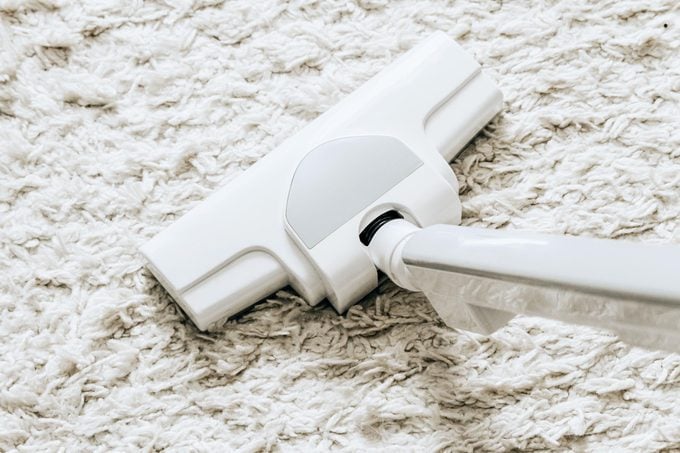
After you pick up the big chunks, vacuum the carpet to remove loose material, Cady says. Scrape again if needed. Don’t yank out the fibers, but try to get as much poop out of the carpet as possible before moving to the next step.
3. Apply a cleaning solution
Make a solution of one-quarter teaspoon of dish soap and one cup of warm water in a bowl. (Alternatively, use one cup of plain white vinegar and two cups of warm water.) Apply with a clean, white cloth and blot carefully. Don’t saturate the base of the carpet or the pad.
4. Blot, rinse and repeat
Blot the stain with the wet cloth, working from the outside and moving inward. Then repeat: Dip a clean portion of the cloth into the solution and blot the stain again. No rubbing! You could make the stain worse. Repeat the process until the poop has disappeared.
5. Rinse and dry
Rinse the clean carpet fibers multiple times with warm tap water. Again, don’t saturate the carpet base or pad. Dunk a clean towel in plain water and repeatedly dab the spot to remove cleaner residues. Blot the carpet dry between rinses, and dry thoroughly once you’re done.
How to get dog poop out of carpet with an enzyme carpet cleaner
Cleaning and blotting by hand takes time and patience. What if you don’t have either? Jay Kellis, a chemist at Bissell Homecare, says enzymatic carpet cleaners make things easier. And they work on both fresh and dried poop.
Enzymes are biological substances that speed up chemical reactions, so they actually “eat” the microscopic particles that make up the stain, Kellis says. These types of cleaners (including enzyme-based pet stain removers) can digest stains and smells that have penetrated deep into the carpet pad—and can make it less likely your pup will poop there again.
But Cross advises caution. You need to follow the cleaner’s instructions to a T. Often it’s best to replace the section of carpet and pad if the damage is extensive. “[T]here are enzyme-digester products that really work, but you need to follow directions exactly,” he says.
Supplies you’ll need
- Plastic bag or gloves
- Paper towels
- Spoon
- Enzymatic carpet cleaner
- Dry white towels
1. Remove as much poop as possible
Once again, clean up as much poop as you can with paper towels, plastic gloves or a plastic bag. Scoop loose poop with a spoon, and blot liquids with a paper towel. Enzymes are happy to chow down on poop in your carpeting, but don’t make the meal too big. It’ll take forever or may leave stuff behind.
2. Spray with an enzyme cleaner
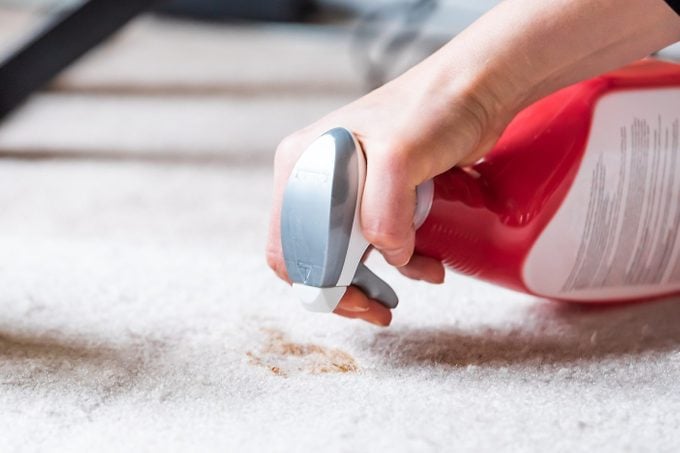
Test for colorfastness by spraying a small, inconspicuous area of your carpeting with the cleaner. If it’s OK after an hour, saturate the poop stain with the enzymatic cleaner. “Once the spray is released from the bottle, the probiotics are activated and begin working,” Kellis says.
3. Cover the stain
Drape a damp towel over the stain and leave it undisturbed for 24 hours or as long as indicated in the directions. Seriously, don’t touch it. Give the enzymes time to eat in peace.
4. Clean as directed
For best results, follow the instructions on the enzymatic cleaner package.
5. Dry
Dry thoroughly with fans or fresh air. Be sure to keep your pets away from the area as it dries!
How to clean dog poop from upholstered items
Carpet’s bad enough, but dogs aren’t exactly known for their discernment when it comes to pooping. (After all, you’re reading this article.) For pooped-on upholstered items like couches, chairs and dog beds, use the same cleaners—but with a little more care. “Upholstery is thinner and more delicate, and you have to worry about color loss,” Cross says. Test an inconspicuous area before cleaning visible sections of upholstery.
How to get dog poop out of couches and chairs
If you happen to have a removable, washable couch or cushion cover, rejoice! Just take it off and clean it as indicated on the care label. If you’re not so lucky, don’t worry. You can do this! Just use the same simple cleaners—water mixed with dish soap or vinegar—that you would use on carpeting.
Supplies you’ll need
- Plastic bag or gloves
- Spoon
- Dry white towels or paper towels
- Dish soap or vinegar
- Small or medium bowl
Directions
- Wearing gloves or using a plastic bag or paper towel, remove as much solid poop as possible.
- Use a spoon to scoop up any semisolid poop.
- Soak up liquid feces with a clean, white cloth or paper towel.
- Mix 1/4 teaspoon dish soap with 1 cup water (or 1 cup vinegar and 2 cups water).
- Apply the solution to the spot with a clean cloth.
- Blot and dab—do not rub. Work from the outside in to prevent spreading the stain.
- Have patience. Reapply the solution and continue blotting for as long as the poop is being transferred to a clean cloth.
- Rinse and dry thoroughly.
How to get dog poop out of dog beds
Dog beds covered with mud, hair and slobber probably fly under the radar. If you cleaned your pup’s perch every day, you’d never get anything done! Add poop to the mix, though, and there’s no ignoring it. If your dog bed has a washable cover, remove it and throw it in the wash. If not, follow the instructions below.
Supplies you’ll need
- Plastic bag or gloves
- Dry white towels or paper towels
- Spoon
- Dish soap or vinegar
- Small or medium bowl
Directions
- Remove as much solid poop as possible using a paper towel, plastic gloves or plastic bag.
- Scoop up semisolid poop with a spoon.
- Soak up liquid feces with a clean, white cloth or paper towel.
- Mix 1/4 teaspoon dish soap with 1 cup water (or 1 cup vinegar with 2 cups water) in a small bowl.
- Apply the solution to the spot with a clean cloth.
- Blot and dab—do not rub. Work from the outside in to prevent spreading the stain.
- Reapply the solution, then continue blotting for as long as poop is being transferred to a clean cloth.
- Rinse and dry thoroughly.
How to get a dog to stop pooping in the house
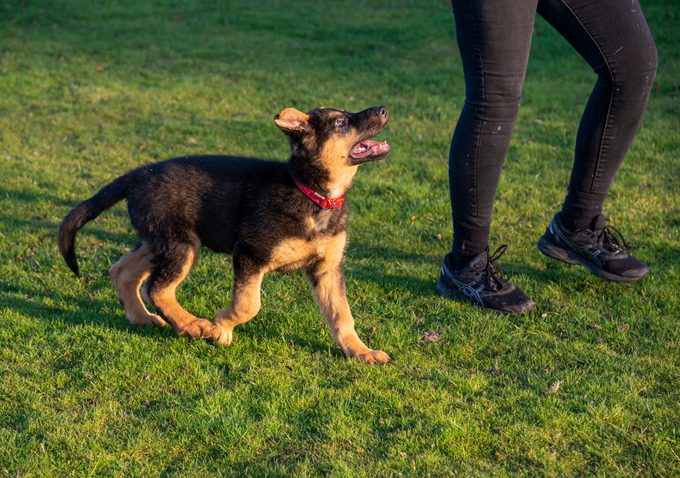
Puppies that aren’t housebroken yet are likely to have accidents, and the key is patience and positive reinforcement, according to Amanda E. Florsheim, DVM, veterinarian, certified pet behavior consultant and owner of Veterinary Behavior Solutions in Carrollton, Texas. For dogs that are housebroken, eliminating inside could be a sign of a medical problem, so keep a watchful eye over any changes in behavior. Talk to your vet if accidents continue.
Here’s what to do when faced with a pooch that keeps pooping in the house:
- Rule out medical causes. This could be a digestive issue, anxiety or problems that seem unrelated, like arthritis. Florsheim says dogs “who have a hard time posturing to poop” may come back inside where it’s more comfortable to finish their business. Sometimes, it’s the first sign pet parents notice.
- Have a signal. A housebroken dog doesn’t want to poo in its home, so start by potty training your puppy. Florsheim recommends teaching it a signal it can use when it needs to go out. Ringing a bell is a popular action, as is tapping a paw (just make sure you don’t have carpeting by the door!).
- Go outside with them. Sometimes dogs get so excited barking at strangers that they forget to go to the bathroom outside. Once they’re back in: “Oops! Need to go now,” Florsheim says. To get around this, go outside with your pup so you can immediately reward it when it poops where it’s supposed to.
- Remove stressors. Pay attention to your dog’s quirks. Is your Chihuahua struggling in the tall grass? Does your rescue need a calm place away from the busy street? “Some dogs can associate being outside with scary noises or nighttime visitors,” Florsheim says. Make accommodations if you can.
- Reinforce positive behavior. When your pup goes potty, praise it profusely (and immediately) and give a high-value dog treat. It’s important not to wait; otherwise, your dogs won’t associate the treat with the action.
- Use praise, never punishment. Never physically or verbally abuse a dog. If you find poop in the house, don’t rub its nose in it. It will only make your pup afraid of you, and it could even cause your dog to hide where it poops, Florsheim says.
- Clean up messes. “The smell of urine and feces is reinforcing for dogs,” Florsheim says. That means that if they smell it on your carpeting, they’ll think that’s where they’re supposed to go. Florsheim recommends using an enzyme cleaner to remove all traces of pee and poop so your dog won’t be tempted.
FAQs
What is the best poop-stain remover?
It depends on who you ask. Cross says that, hands down, it’s dish soap, which works on a wide range of poop stains and is safe on most carpets. Cady agrees that soapy water will get the job done, as will a vinegar solution. But her go-to pick is a cleaner certified by the CRI. Look for the CRI seal of approval on the package, or search the CRI’s database of certified cleaning solutions. You’ll even find pet-stain busters in the bunch.
Neither Cady nor the CRI recommend using other common internet remedies, like baking soda and hydrogen peroxide.
Do I need a machine?
Blotting and patience are generally all you need to clean poop from carpeting, according to the experts. But “a machine that injects hot water and vacuums it out, much like a rental machine you would see at a store, is even better,” Cross says. If you have one or are willing to spend money on a rental, it can save you a lot of time.
You can also use a portable home carpet cleaner to get the job done. If you have one (and lack the patience other methods require), use it with the recommended pet cleaner for your machine—dish soap will be too sudsy. For best results, follow the directions in your user guide, Kellis says.
Don’t have a carpet cleaner and don’t want to rent a machine? That’s perfectly fine.
How do I get rid of the poop smell in my house?
To remove stubborn odors like dog pee and poop, go with an enzyme cleaner. These products are proven to digest odor-causing bacteria. Cross says it’s important to follow the directions exactly.
Of note: If the pad or subfloor is soaked with pet poop, the odors will be difficult to completely eradicate. Cross recommends replacing the section of carpet and pad for best results.
Why does my dog keep pooping on the carpet?
There are several reasons your dog is regularly leaving behind these less-than-pleasant presents. Canines have an extraordinary sense of smell, so the problem is self-reinforcing. “Unless an area is cleaned with a good enzymatic cleaner, dogs can still smell the small remnants that regular cleaning can leave behind,” Florsheim says.
If you’re not keen on re-cleaning the spot, try this trick from cleaning expert Ann Russell, TikTok’s “cleaning auntie” and the author of How to Clean Everything: “Something I find helpful is to cover marks with a disposable pee pad (or a bed pad) for a week or so, so that re-marking won’t recontaminate the spot,” she says. “It gives enzymes a chance to work, and any secondary peeing can be removed in seconds. Those noses can pick up the faintest odor that ours cannot.”
Dog anxiety is another potential cause. Your dog could also be marking its territory, or it may have a physical problem. Finding the root cause will help guide the solution, so talk to your veterinarian if you’re concerned.
Why trust us
At Reader’s Digest, we’re committed to producing high-quality content by writers with expertise and experience in their field in consultation with relevant, qualified experts. For this piece, Ally Childress tapped her experience as a home and cleaning journalist, and then Ann Russell, TikTok’s “cleaning auntie” and the author of How to Clean Everything, gave it a rigorous review to ensure that all information is accurate and offers the best possible advice to readers. For this piece, we relied on reputable primary sources, including carpet-cleaning experts and a veterinarian and pet behaviorist. We verified all facts and data and backed them with credible sourcing, and we will revisit them over time to ensure they remain accurate and up to date. Read more about our team, our contributors and our editorial policies.
Sources:
- Jeff Cross, carpet-cleaning specialist and media director for ISSA—The Worldwide Cleaning Industry Association; email interview, Feb. 1, 2024
- Karen Cady, program manager for the Carpet and Rug Institute’s Seal of Approval program; email interview, Feb. 5, 2024
- Jay Kellis, staff chemist with Bissell Homecare; email interview, Feb. 1, 2024
- Amanda E. Florsheim, DVM, veterinarian, pet behaviorist and owner of Veterinary Behavior Solutions; email interview, Feb. 6, 2024
- Ann Russell, TikTok’s “cleaning auntie” and the author of How to Clean Everything


